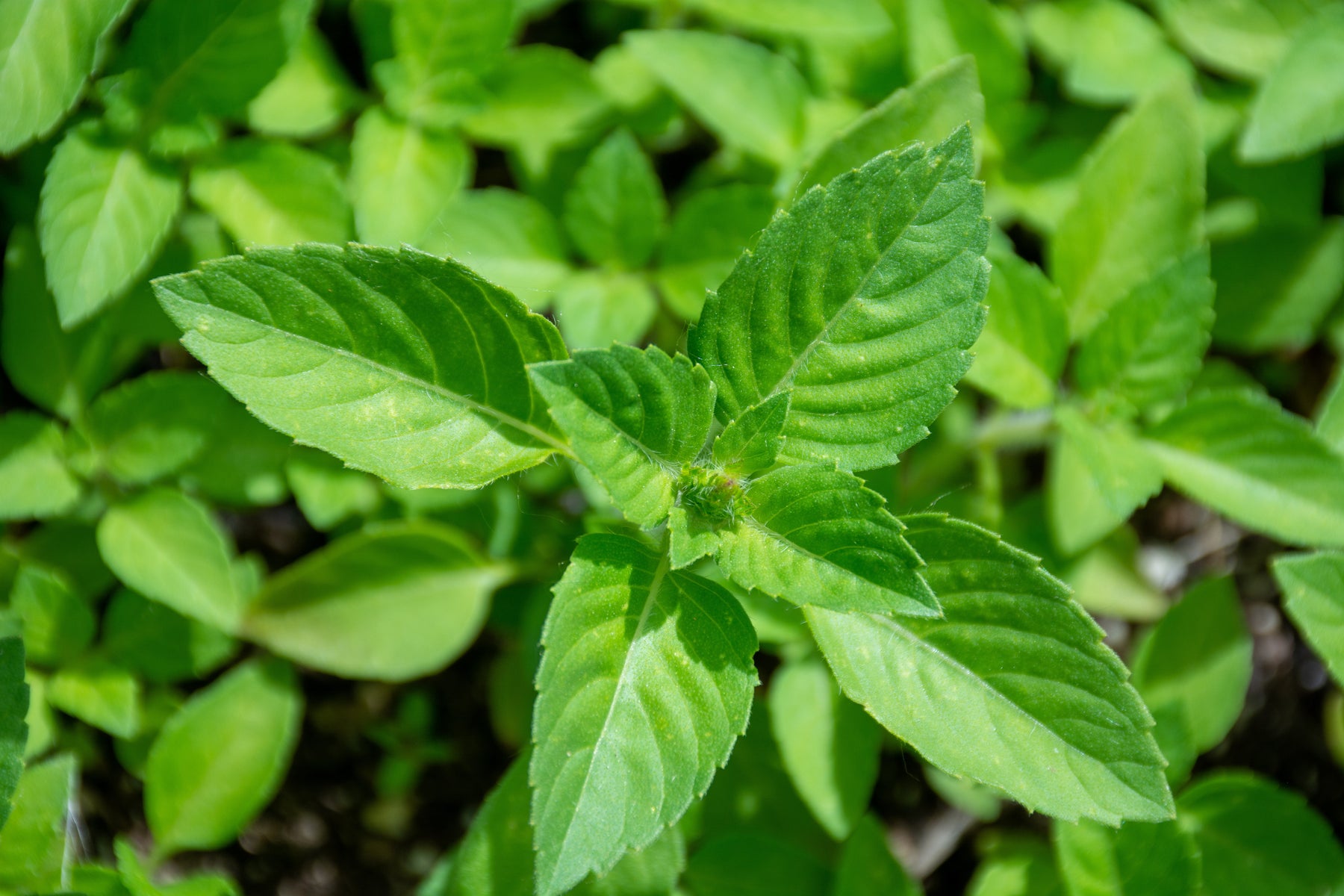Tulsi, also known as Tulasi in Sanskrit, or holy basil in English, is a culinary and medicinal aromatic herb. It is indigenous to the Indian continent and highly revered for its medicinal uses within the Ayurvedic and Siddha medical systems.
At Nature’s laboratory we are proud to supply this important herb, in the form of Tulsi cut herbs, Tulsi tincture and Tulsi essential oil.
Biological Source
Tulsi is a herb from the family Lamiaceae.
Background and Historical uses of Ocimum sanctum
Tulsi has been used within Ayurvedic medicine for more than 3000 years. In the Ayurveda system Tulsi is often referred to as an “Elixir of Life” for its healing powers and has been known to treat many different common health conditions[1]. Tulsi is one of the principal herbs used in the Ayurvedic medicine system, in which it is known alternately as “The Queen of Herbs,”. It holds a supreme place in the ancient Vedic scriptures and is integrated into daily life by Hindus through religious worship. Hindu homes typically have a Tulsi plant growing in an earthen pot in or around the home. In Ayurveda, it is believed that the best way to take Tulsi medicinally is in its raw, fresh, whole form as a hot water infusion[2].Tulsi is perhaps one of the best examples of Ayurveda’s holistic lifestyle approach to health. Three types of Tulsi are commonly described. Ocimum tenuiflorum (or Ocimum sanctum L.) includes 2 botanically and phytochemically distinct cultivars that include Rama or Sri Tulsi (green leaves) and Krishna or Shyama Tulsi (purplish leaves)[3],[4]. Ocimum gratissimum is a third type of Tulsi known as Vana or wild/forest Tulsi (dark green leaves)[5]. Tulsi is effective in various skin disorders. Traditionally people use its paste to treat rashes, insects’ bites, and itching. The tree or whole plant is used in ring worm infections and leukoderma.
Macroscopical details: Ocimum sanctum, commonly known as Tulsi, is an erect, perennial herb with a characteristic aroma and growing up to a height of 30–60 cm. It is commonly propagated through seeds. The leaves of Tulsi are up to 5 cm long and simple, branched, opposite, obtuse, elliptical, and oblong with a dentate margin. Small hairy structures are found from the root to stem. The flowers are small and reddish purple in colour presented in compact clusters on cylindrical spikes. Fruits are small and when ripe seeds appear reddish-yellow in colour. Leaves are light green to dark purple greenish in colour.
Phytochemical Details: Several phytochemicals like tannins, saponins, phlobatannins, flavonoids, phenolics, terpenoids, glycosides, and steroids with other mineral and micronutrients have been reported in various parts of Tulsi. The wide variety of treatments using Ocimum sanctum is possible due to its complex chemical constituents. Phenolic compounds are important secondary plant metabolites and show notable health benefits. These compounds play different physiological roles in plants; they are used as growth regulators and as important precursor molecules for the biosynthesis of other molecules such as lignin and suberin, which are produced as a defence against different biotic and abiotic stresses. Terpenes are major constituents of essential oil[6]. The unique aromatic odour of O. sanctum is due to the presence of essential or volatile oils. The aromatic volatile oil mainly constitutes phenols, terpenes, and aldehydes. The volatile oils are mainly concentrated in the leaf. The leaf of O. sanctum contains 0.7% volatile oil comprising about 71% eugenol and 20% methyl eugenol.

Tulsi also contains other constituents, namely, carvacrol, ursolic acid[7], linalool, and limatrol. The volatile oil from the seed contains sitosterol and fatty acids.

Ursolic Acid
There are three coumarins constituents extracted from the Tulsi plant named aeculetin, aesculin and ocimarin[8]. Ocimum sanctum leaves revealed seven novel neolignans named as Tulsinol A to Tulsinol G.
Medicinal Uses
Stress Resilience: Ocimum sanctum has been recognized for extensive stress resilience in modern medicinal and pharmacognostic research and studies. It has been found that Tulsi holds potent adaptogenic properties[9]. Chewing 12 leaves of Tulsi twice a day helps a person to get efficient relief from stress[10].
Antioxidant Potential: A stressful lifestyle and various environmental factors like pesticides, chemical pollutants, and UV radiations contribute to reactive oxygen overproduction in the body which causes tissue damage leading to a deterioration in health. Polyphenolic compounds from Tulsi effectively impede hydrolytic and oxidative enzymes, decrease blood glucose and lipid level, and enhance immunity. The existence of hydroxyl groups and keto groups in phytochemicals of Ocimum sanctum imparts free radical scavenging activity and produces antioxidant activity[11].
Anti-inflammatory activity: It has been reported that Ocimum sanctum leaves and seeds reduce the level of uric acid, a causal factor of arthritis and joint inflammation (Sarkar et al., 1990). The anti-inflammatory activity of compounds isolated from this plant’s aerial parts named rosmarinic acid, apigenin, isothymusin, isothymonin, cirsimaritin, cirsineol and eugenol has been reported for cyclooxygenase-1 (COX-1) and COX-2 inhibitory activities in human prostaglandin H synthase isozymes (hPGHS-1).
Anti-infective remedy: Modern research has uncovered that Tulsi has anti-bacterial, anti-viral and anti-fungal activity[12] that comprises activity against many pathogens accountable for human infections. Tulsi has been proved for its broad-spectrum activity, which includes activity against Streptococcus mutans, the organism responsible for tooth decay, which further suggests that it could be used as a herbal mouth wash for treating bad breath, gum disease and mouth ulcers. Tulsi has also been demonstrated to be active against many animal pathogens, and this has led to Tulsi being used in animal tending to reduce infections in cows[13], poultry[14],goats, fish and silkworms.
Liquid Yoga: Regular intake of Tulsi tea may be compared with the regular practice of yoga, which can be considered “adaptogenic” through nurturing and nourishing the body -mind- spirit while fostering a sense of relaxation and wellbeing. Like yoga, Tulsi has a calming effect that leads to clarity of thought, along with a more relaxed and calm disposition. The cognitive and memory-enhancing properties of Tulsi therefore differ from those of caffeine-containing beverages such as coffee and tea, which heighten arousal and may cause physical and mental agitation. Furthermore, Tulsi does not produce the same physical dependence as caffeine and can be safely consumed on a regular basis without the fear of withdrawal effects[15].
It is evident that Tulsi is a medicinal plant of great significance because of its diverse applications in medicine, and is justifiably called the “Queen of Herbs” or “Elixir of life”.
[1]. Nadkarni K., Nadkarni A. Indian Materia Medica with Ayurvedic, Unani-Tibbi, Siddha, Allopathic, Homeopathic, Naturopathic & Home Remedies. Vol. 2. Bombay, India: Popular Prakashan Private Ltd; 1982.
[2] Singh N, Hoette Y. Tulsi: The Mother Medicine of Nature. Lucknow, India: International Institute of Herbal Medicine; 2002.
[3]. Kothari S. K., Bhattacharya A. K., Ramesh S., Garg S. N., Khanuja S. P. S. Volatile constituents in oil from different plant parts of methyl eugenol rich Ocimum tenuiflorum L.f. (syn. O. sanctum L.) grown in South India. Journal of Essential Oil Research. 2005;17(6):656–658.
[4]. Parotta J. A. Healing Plants of Peninsular India. Oxfordshire, UK: CABI; 2001.
[5]. Orwa C., Mutua A., Kindt R., Jamnadass R., Simons A. Agroforestree Database: A Tree Species Reference and Selection Guide Version 4.0. Nairobi, Kenya: World Agroforestry Centre ICRAF; 2009.
[6]. Gupta P, Yadav DK, Siripurapu KB et al (2007) Constituents of Ocimum sanctum with antistress activity. J Nat Prod 70(9):1410–1416.
[7]. Pandey AK, Singh P, Tripathi NN (2014) Chemistry and bioactivities of essential oils of some Ocimum species: an overview. Asian Pac J Trop Biomed 4(9):682–694
[8]. Singh D, Kumar Chaudhuri P, Darokar MP. New antiproliferative tricyclic sesquiterpenoid from the leaves of Ocimum sanctum. Helvetica Chimica Acta. 2014
[9]. Mahdi AA, Chandra A, Singh RK et al (2003) Effect of herbal hypoglycemic agents on oxidative stress and antioxidant status in diabetic rats. Indian J Clin Biochem 18(2):8–15.
[10]. Jothie Richard E, Illuri R, Bethapudi B et al (2016) Anti-stress activity of Ocimum sanctum: possible effects on hypothalamic-pituitary-adrenal axis. Phytother Res 30(5):805–814.
[11]. Shetty S, Udupa S, Udupa L (2008) Evaluation of antioxidant and wound healing effects of alcoholic and aqueous extract of Ocimum sanctum Linn in rats. Evid Based Complement Altern Med 5:95.
[12]. Vasudevan P, Kashyap S, Sharma S. Bioactive botanicals from basil (Ocimum sp.) J Sci Ind Res (C) 1999;58:332–8.
[13]. Kumar S, Gupta HP, Prasad S, Rajora VS, Prasad JK. Antibacterial properties of garlic and Tulsi in repeat breeding crossbred cows. Indian Vet J. 2011; 88:28–30.
[14]. Sadekar RO, Pimprikar NM, Bhandarkar AG, Barmase BS. Immunomodulating effect of Ocimum sanctum linn. Dry leaf powder on humoral immune response in poultry naturally infected with IBD virus. Indian Vet J. 1998; 75:73–4.
[15]. Cohen MM. Tulsi – Ocimum sanctum: A herb for all reasons. J Ayurveda Integr Med. 2014 Oct-Dec;5(4):251-9

